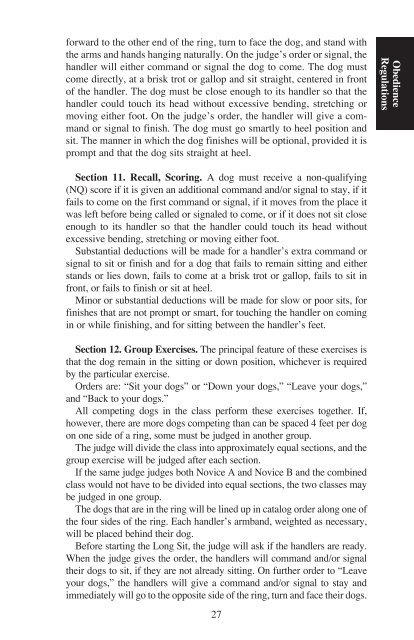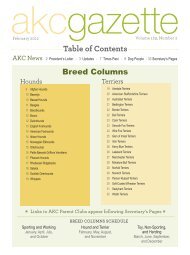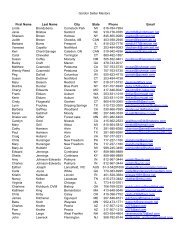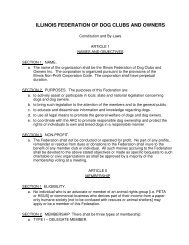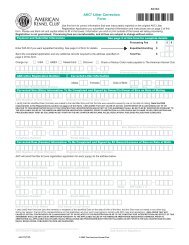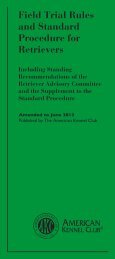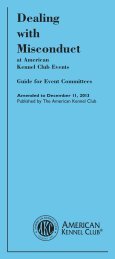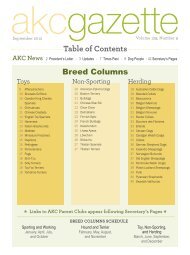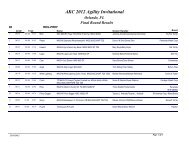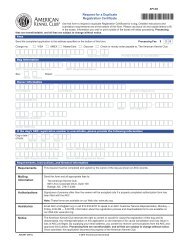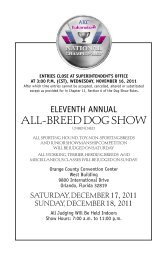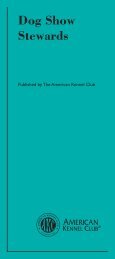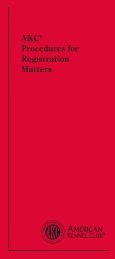Obedience Regulations - American Kennel Club
Obedience Regulations - American Kennel Club
Obedience Regulations - American Kennel Club
Create successful ePaper yourself
Turn your PDF publications into a flip-book with our unique Google optimized e-Paper software.
forward to the other end of the ring, turn to face the dog, and stand with<br />
the arms and hands hanging naturally. on the judge’s order or signal, the<br />
handler will either command or signal the dog to come. the dog must<br />
come directly, at a brisk trot or gallop and sit straight, centered in front<br />
of the handler. the dog must be close enough to its handler so that the<br />
handler could touch its head without excessive bending, stretching or<br />
moving either foot. on the judge’s order, the handler will give a command<br />
or signal to finish. the dog must go smartly to heel position and<br />
sit. the manner in which the dog finishes will be optional, provided it is<br />
prompt and that the dog sits straight at heel.<br />
Section 11. Recall, Scoring. A dog must receive a non-qualifying<br />
(nQ) score if it is given an additional command and/or signal to stay, if it<br />
fails to come on the first command or signal, if it moves from the place it<br />
was left before being called or signaled to come, or if it does not sit close<br />
enough to its handler so that the handler could touch its head without<br />
excessive bending, stretching or moving either foot.<br />
substantial deductions will be made for a handler’s extra command or<br />
signal to sit or finish and for a dog that fails to remain sitting and either<br />
stands or lies down, fails to come at a brisk trot or gallop, fails to sit in<br />
front, or fails to finish or sit at heel.<br />
minor or substantial deductions will be made for slow or poor sits, for<br />
finishes that are not prompt or smart, for touching the handler on coming<br />
in or while finishing, and for sitting between the handler’s feet.<br />
Section 12. Group Exercises. the principal feature of these exercises is<br />
that the dog remain in the sitting or down position, whichever is required<br />
by the particular exercise.<br />
orders are: “sit your dogs” or “Down your dogs,” “leave your dogs,”<br />
and “back to your dogs.”<br />
All competing dogs in the class perform these exercises together. if,<br />
however, there are more dogs competing than can be spaced 4 feet per dog<br />
on one side of a ring, some must be judged in another group.<br />
the judge will divide the class into approximately equal sections, and the<br />
group exercise will be judged after each section.<br />
if the same judge judges both novice A and novice b and the combined<br />
class would not have to be divided into equal sections, the two classes may<br />
be judged in one group.<br />
the dogs that are in the ring will be lined up in catalog order along one of<br />
the four sides of the ring. each handler’s armband, weighted as necessary,<br />
will be placed behind their dog.<br />
before starting the long sit, the judge will ask if the handlers are ready.<br />
When the judge gives the order, the handlers will command and/or signal<br />
their dogs to sit, if they are not already sitting. on further order to “leave<br />
your dogs,” the handlers will give a command and/or signal to stay and<br />
immediately will go to the opposite side of the ring, turn and face their dogs.<br />
27<br />
<strong>Obedience</strong><br />
<strong>Regulations</strong>


